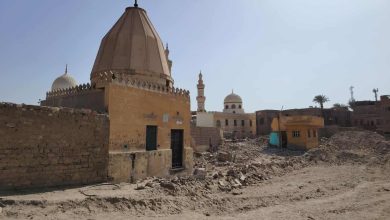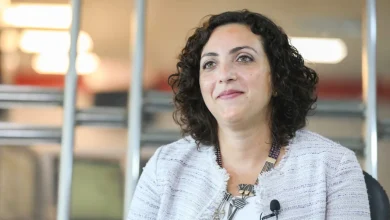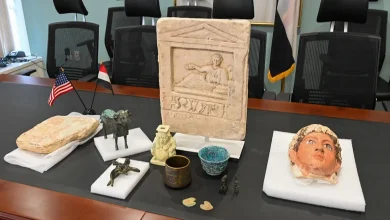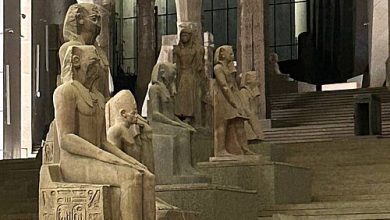
Remains of the Poet are no more: the demolition of Mahmoud Sami al-Baroudi’s Mausoleum
Cairo’s historic cemeteries witnessed yet another demolition on 6 February 2025 of the mausoleum of poet and former minister of Education and Religious Endowments respectively, Mahmoud Sami al-Baroudi, a structure dating back to more than 120 years. Considered part of the historical fabric of Cairo, its destruction has raised numerous questions regarding the roles of the Ministries of Endowments and Culture in preserving heritage.
Earlier Decisions to Halt Demolition
The demolition contradicts earlier statements made by Egyptian Prime Minister Dr. Mostafa Madbouly last October. He had affirmed that all government officials were committed to preserving monuments—be they officially registered sites or heritage buildings of intrinsic value.
In his remarks, Madbouly added that the demolition of some buildings in the Imam al-Shafi’i cemetery area and elsewhere had been promptly halted. He highlighted that such artistic and architecturally important structures are held in great esteem [by the government] and are to remain untouched. Additionally, he assured that any past actions sparking controversy, misunderstanding, or overreach would not be repeated in the future.
Mahmoud Sami al-Baroudi’s Mausoleum
According to Al-Waqa’i’ Al-Masriyya (Issue 74, March 29, 2023), a statement was issued by the Cairo Governorate – Southern District, along with the Distinguished Architectural Style Committee, listing the names of cemeteries and properties to be added to the registers of buildings and properties recognized for their distinguished architectural style. Among these was the Mahmoud Sami al-Baroudi’s mausoleum, which was assigned the documentation number (04240000198). The mausoleum located in the Tahaweiya vicinity, was included last September among the cemeteries designated as part of cultural heritage within the demolition zone.


The Demolition of the Mausoleum
An eyewitness who requested anonymity recounted behind-the-scenes details of the cemetery’s demolition, stating, “The remains [of the poet] were transferred from the cemetery three months ago, and the structural components of his mausoleum were also removed.” Speaking to Bab Masr, he added, “Mahmoud Sami al-Baroudi’s mausoleum is located in the Ibn al-Fared section, where other cemeteries—such as the mausoleum of Younis Sabry and that of Ibrahim Bek Halim—have also been demolished.”
He further noted that three other structures—the mausoleums of Mahmoud al-Falaki, Rashwan Abdullah, and al-Khazandar—remain intact for now, although they are scheduled to be dismantled and relocated.
The Role of the Authorities
The demolition of Mahmoud Sami al-Baroudi’s mausoleum was sharply condemned by Dr. Mohammed Hamza al-Haddad, Dean of the Faculty of Archaeology and former Vice President of Cairo University. In a statement to Bab Masr, he wondered: “How can the demolition proceed when, just months ago, the head of government stated that all such actions would be halted?” He added, “The issue isn’t limited to the demolition of al-Baroudi’s mausoleum; it also involves the removal of other cemeteries in the vicinity that represent 150 years of Egyptian civilization and embody irreplaceable symbols of the nation’s elite.”
Regarding the removal of this structure from the list of buildings with distinguished architectural style—he wondered further: “Who is responsible for failing to register it as an antiquity? What recent developments have led to its removal from the distinguished style list? These are all questions that remain unanswered.“
He further criticized the lack of intervention on the Ministries of Culture and Religious Endowments stating: “Al-Qarafa is an interconnected fabric, and all the demolished cemeteries are endowed properties. Where are the roles of the Ministry of Endowments and the Ministry of Culture in safeguarding them?”
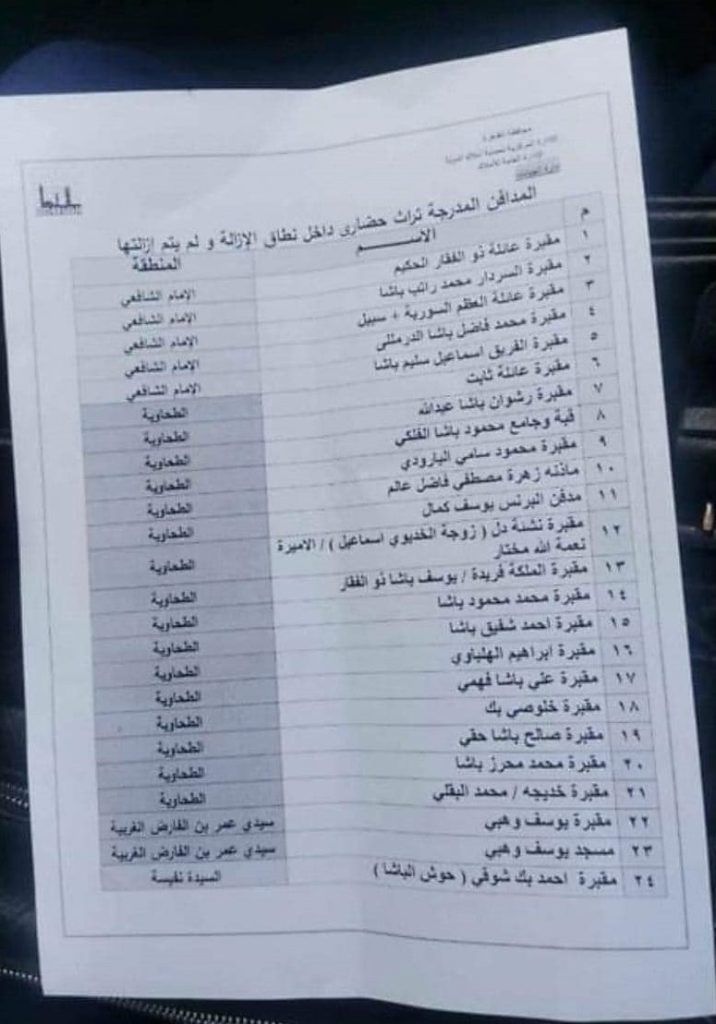
The Fabric of Historic Cairo
“We emphasize that we are not against modernization, development, or sustainable tourism. We rather support progress and the creation of new transportation corridors as part of Cairo’s urban expansion over the past decade. However, this progress must not come at the expense of our Egyptian identity, which is embodied in our historical heritage and long-established culture,” Al Haddad continued.
In this context, Al-Haddad expressed his disapproval of Decree No. 1045 of 2024, issued by Engineer Sherif Al-Sharbiny, Minister of Housing which included the removal of 10 mausoleums from the register of buildings with distinguished architectural style, paving the way for their demolition. “There are several alternatives that align with the President’s directives and the guidelines of the formed committee, and we need better coordination among government agencies and the relevant ministries to safeguard our heritage,” he added.
Regarding the history of Cairo’s historic cemeteries, he goes on to say: “These mausoleums have been in existence since 1426. Even landmarks like Mohamed Ali Palace were built on archeological sites that predate them, proving that these locations constitute an integral part of our cultural history. Excavating any cemetery could uncover significant artifacts and treasures, including tombstones that are a part of our heritage.”
He also highlighted the alarming issue of tombstone theft by unidentified individuals, explaining, “What makes matters worse is that many archaeological artifacts have been smuggled abroad, with middlemen selling them through online auctions. It is unfortunate to see these relics and antiquities displayed in auction houses.”
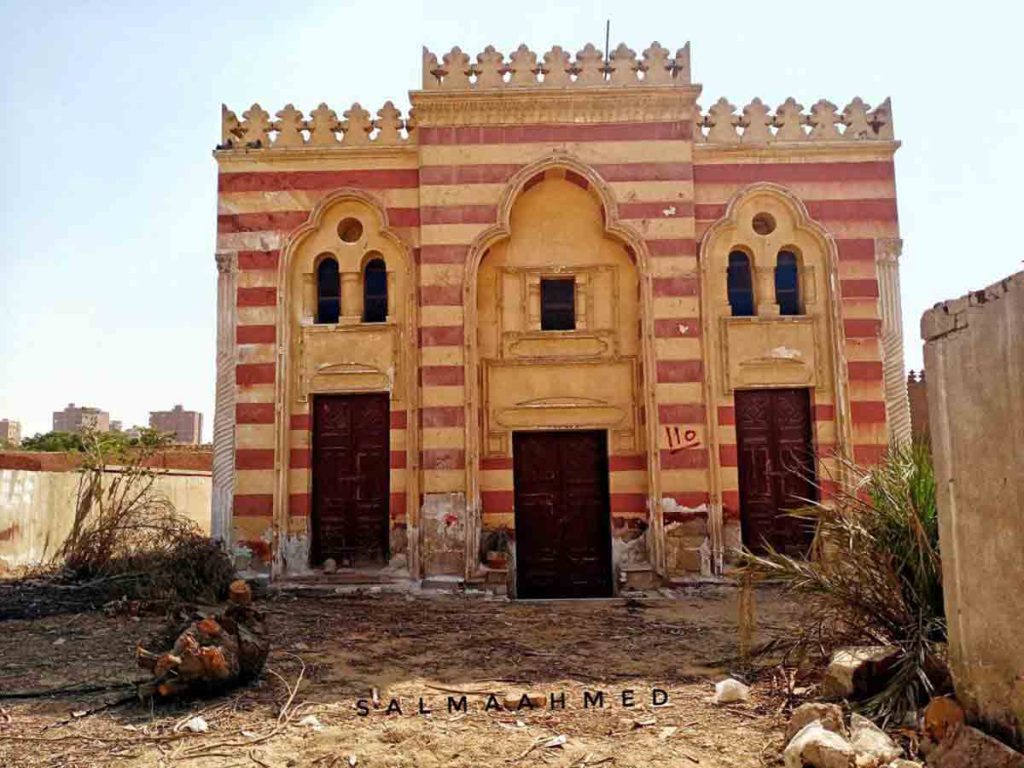
Al-Baroudi’s Journey from Ministry to Exile
Mahmoud Sami al-Baroudi (1839 – 1904) was of Circassian descent, belonging to the Saifi Nooruz al-Atabaki lineage and the brother of Barsbay. He joined the Ottoman army and emerged as a poet who deeply cherished Arab heritage—credited as the first modern-era poet to write a preface for a modern diwan of poetry.
According to Sheikh Kamel Mohamed Awieda’s Notables Among Writers and Poets: Mahmoud Sami al-Baroudi, Imam of the Poets in the Modern Era (Al-A’lam min al-Adibba’ wa al-Shu’ara’: Mahmoud Sami al-Baroudi, Imam al-Shu’ara in the Modern Era (Dar al-Kutub al-Ilmiyya, Beirut), after his early military service, al-Baroudi transitioned to work at the Ministry of Foreign Affairs. He later participated in the Ottoman campaign in Egypt against Russia, Romania, and Bulgaria, earning a promotion to brigadier general upon the campaign’s return.
In 1879, he was appointed Minister of Education, and subsequently served as Minister of Endowments. By 1881, he became Minister of War, and in 1882 he assumed leadership over both public and internal affairs—a role that earned his ministry the nickname “Ministry of Revolution.” One of the leaders of the Urabi Revolution he was eventually sentenced to death and this sentence was later commuted to lifelong exile on the island of Serendib (Sri Lanka), where he remained for over 17 years.
Upon his return to Egypt, al-Baroudi welcomed writers and poets at his home, choosing to give up on politics until he died..

